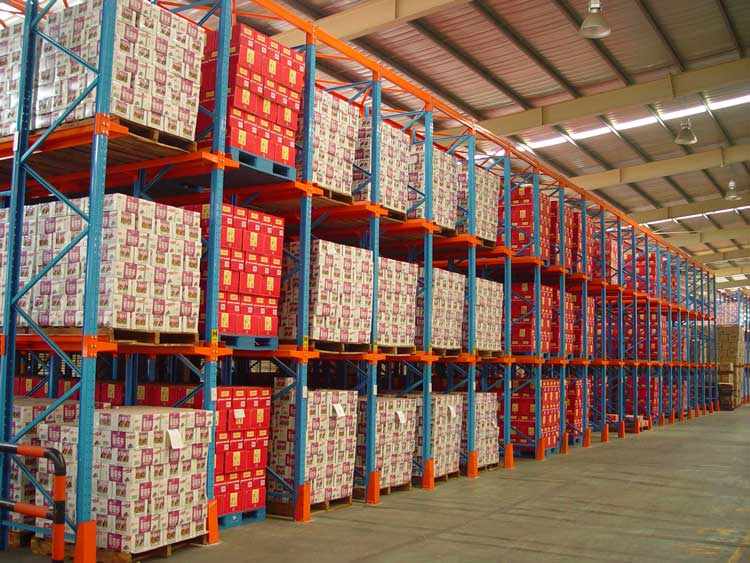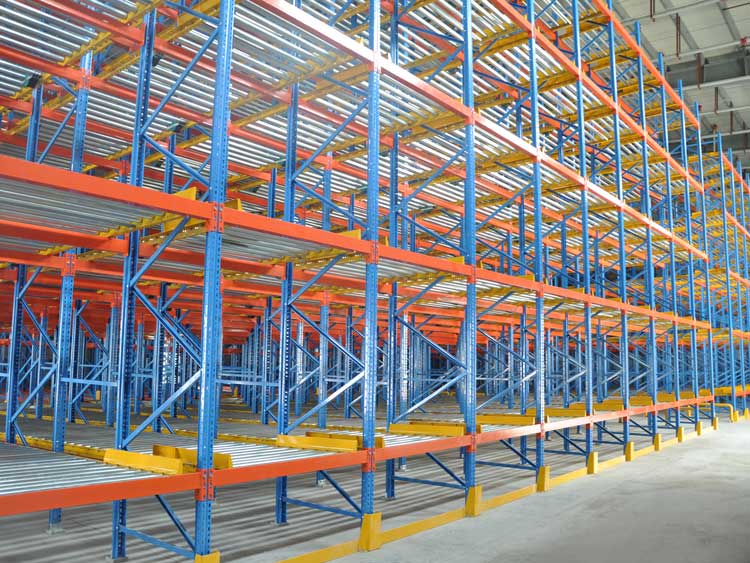Both drive in rack and gravity racks belong to the category of pallet storage racks and are also commonly used types of racks in warehousing operations. Both gravity racks and drive in racks can store products with pallets as auxiliary equipment, and they are both whole-building racks, with almost twice the storage capacity compared to regular pallet racks. So what are the differences between these two types of storage racks?
1. Working principle

Working principle of drive in rack
The drive in racks, also known as drive through racks, are continuous whole building rack that is not divided by channels. On the support rails (brackets), pallets are stored in the depth direction, one after another, making high-density storage possible. Goods can be stored and retrieved from the same side of the storage rack, with first storage and then retrieval, and then storage and first retrieval. Balanced-weight battery forklifts and forward-moving battery forklifts can easily drive into the rack to store and retrieve goods without occupying multiple channels. The stability of the drive in rack system is relatively weak among all types of racks, so the drive in rack should not be too high, usually within 10m. In addition, the warehouse racking system also needs to be equipped with a tensioning device.

Working principle of gravity rack
The structure of gravity racks is similar to that of crossbeam pallet racks, with the difference being that roller tracks are installed on the crossbeam of gravity racks, and the tracks tilt at an angle of 3-5 °. Forklifts do not need to enter the aisle, they only need to transport the pallet of goods to the rack inlet (with the high end as the inlet and the low end as the outlet). By utilizing the weight of the goods themselves, the pallet automatically slides from the inlet to the other end of the reclaiming port. During the sliding process of goods, the sliding speed of the goods is controlled by a damper on the slide to maintain it within a safe range. A separator is installed at one end of the slide for shipment, and the handling machinery can smoothly remove the goods at the first plate position. The total depth of the storage rack (i.e. the length of the guide rail) should not be too large, otherwise the unusable upper and lower “dead corners” will be large, affecting space utilization. Moreover, if the ramp is too long, the controllability of the slide will be poor, and the impact of the slide will be large, which can easily cause the slide to be blocked and blocked, and the pallet goods to tip over.
2. Scope of use
The scope of use of drive in racks
The drive in racks are suitable for storing goods with a small variety and a large quantity. They are commonly used to store enlarged batches of the same type of goods and have a high utilization rate of warehouse space. They are suitable for occasions with high storage space costs such as the food industry, chemical industry, clothing industry, cold storage, etc. The storage cost per unit site is relatively low.
The scope of use of gravity racks
Gravity racks can be first in first out or first in last out. They are suitable for the first in first out storage of large quantities of similar goods. The space utilization rate is very high, especially suitable for the storage of goods with a certain warranty period that should not be overstocked for a long time, as well as goods of small variety and large quantity. They are widely used in the household goods industry and auto parts industry.
Post time: 07-10-2023





